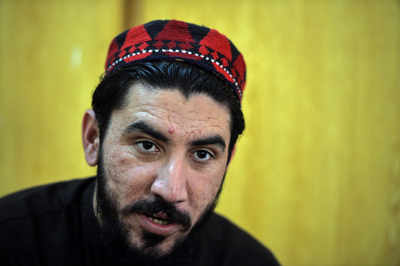- News
- World News
- Pakistan News
- Meet Manzoor Pashteen, the 25-year-old man who defied Pakistan Army
Trending
This story is from January 28, 2020
Meet Manzoor Pashteen, the 25-year-old man who defied Pakistan Army

NEW DELHI: Pakistan human rights activist and the leader of Pashtun Tahafuz Movement Manzoor Pashteen was arrested by security forces on Monday. Here is all you need to know about the charismatic leader and the movement he is leading —
- Who is Manzoor Pashteen?
The son of a primary school teacher Pashteen enjoys massive support across Pakistan. The Twenty-five-year old Pashteen is a human rights activist in Pakistan who has been highlighting the plight ofPashtuns in Pakistan . He is also the chairman of the Pashtun Tahafuz Movement, a social movement for the protection of human rights of ethnic Pashtuns in the restive tribal areas along the border with Afghanistan. He is one of the most vocal opponents of the powerful army and has accused them of abuse of Pashtuns — including enforced disappearances and targeted killings. In 2014, a student of veterinary science, Pashteen started Mahsud Tahafuz Movement, a social movement aimed at removing landmines from Waziristan. The movement was named after Masud tribe in Waziristan. The movement was later renamed as Pashtun Tahafuz Movement (PTM). - Why was
Manzoor Pashteen arrested?
Pashteen was arrested by police from Peshawar in the early hours of Monday on several charges, including sedition, hate speech, incitement against the state, and criminal conspiracy. He was detained along with six others in a pre-dawn raid in the northwestern city of Peshawar on Monday, said a local police official. He said Pashteen was arrested on charges of making anti-government speeches at rallies and inciting violence. He provided no further details. This is not the first time Pashteen has been arrested. In 2017, he was arrested along with his father. He was beaten up under the allegation that his human rights campaign damaged military morale. However, after a sustained social media campaign by his supporters, he was released. - What is Pashtun Long March?
On January 26, 2018, Pashteen along with 20 friends started a protest march from Dera Ismail Khan. The march reached Peshawar two days later and Islamabad on February 1. Many people joined the march along the way. In Islamabad, the group organised a sit-in called "All Pashtun National Jirga". The jirga condemned the murder of the Pashtun shopkeeper Naqeebullah Mehsud who was shot dead by the police force in Karachi during a fake encounter. There was a grand gathering of PTM in the centre of Khyber Pakhtunkhwa, Peshawar on 8 April 2018. - What is Pashtun Tahafuz Movement?
The Pashtun Long March and the subsequent sit-in at Islamabad kicked off the Pashtun Tahafuz Movement. At the sit-in, the protesters asked the government to set up a judicial inquiry for Naqeebullah Mehsud, as well as for all the other Pashtuns murdered extrajudicially in police encounters. It also demanded to stop racial profiling of the Pashtuns in Pakistan and to bring the Pashtun missing persons before the court of law. Since then there have been numerous public gatherings across Pakistan under the banner of PTM. The Pashteen hat (also known as the Mazari hat) has become the most iconic symbol of PTM, as Manzoor Pashteen regularly wears it at public rallies and events. - Why are Pashtuns protesting in Pakistan?
Many of PTM’s supporters are ethnic Pashtuns who hail originally from the borderlands with Afghanistan, the focal point of a near-decade-long insurgency by Islamist militants and subsequent anti-terrorism operations by Pakistan’s military, which displaced millions of people from the area. Most of them are from Afghanistan after they were forced to flee the war. They are the largest ethnic minority in Pakistan constituting 15% of the total population. For years they have been victims of violence and intimidation by militants and security forces.
End of Article
FOLLOW US ON SOCIAL MEDIA










